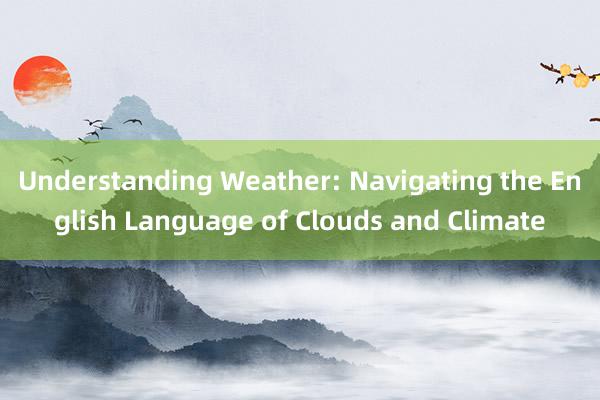
### Understanding Weather: Navigating the English Language of Clouds and Climate
The English language, rich with nuances and expressions, plays a crucial role in the discourse around weather and climate. Whether you're a meteorologist predicting tomorrow's forecast or a layperson trying to understand global climate change, understanding the vocabulary related to clouds and climate is essential. This article aims to demystify some common terms and concepts used in weather and climate discussions.
#### 1. **Cloud Types**
诗词文学- **Cirrus Clouds**: These are high-altitude clouds, typically white and wispy, often indicating fair weather but can also suggest that a change in the weather is on the horizon.
- **Cumulus Clouds**: Known for their fluffy, cotton-like appearance, cumulus clouds are associated with sunny days and can sometimes develop into larger storms if they grow taller than 2,网站建设_网站改版_app商城小程序开发500 feet.
- **Stratus Clouds**: These are low-lying clouds that form a gray layer across the sky, 海口市开富潮百货店 often leading to overcast conditions and light rain or drizzle.
- **Nimbus Clouds**: These are cloud types that bring precipitation. They include cumulonimbus (thunderstorms), 美品(厦门)橡胶制品有限公司 altostratus (mid-level clouds that can produce light precipitation), and cirrostratus (high-level clouds that may precede a storm).
#### 2. **Weather Conditions**
- **Sunny**: A term used to describe clear skies with no clouds.
- **Overcast**: Describes a sky completely covered by clouds,叁陆伍网 often leading to a lack of sunlight.
- **Rain**: Precipitation falling from the clouds in liquid form. It can vary from light drizzle to heavy downpour.
- **Snow**: Precipitation that falls as ice crystals, typically colder temperatures are required for this type of precipitation.
#### 3. **Climate Concepts**
- **Global Warming**: The long-term increase in Earth’s average surface temperature caused by human activities, primarily the emission of greenhouse gases.
- **Carbon Footprint**: The total amount of greenhouse gases emitted as a result of an individual's actions, including energy use, transportation, and waste production.
- **Greenhouse Effect**: A natural process where certain gases in the atmosphere trap heat from the sun, warming the Earth. Human activities have increased the concentration of these gases, enhancing this effect.
#### 4. **Predictive Language**
- **Forecast**: A prediction of future weather conditions, often given by meteorologists based on current and historical data.
- **Trend**: A general direction or pattern observed in weather or climate data over time.
- **Anomaly**: A deviation from the expected or normal conditions. In weather, this could refer to unusually hot or cold temperatures.
Understanding these terms not only helps in comprehending daily weather reports but also in grasping more complex discussions around climate science. As we navigate the complexities of our changing climate叁陆伍网, being fluent in the language of clouds and climate becomes increasingly important. This knowledge empowers individuals to make informed decisions about environmental sustainability and personal behavior changes that can mitigate the impacts of climate change.